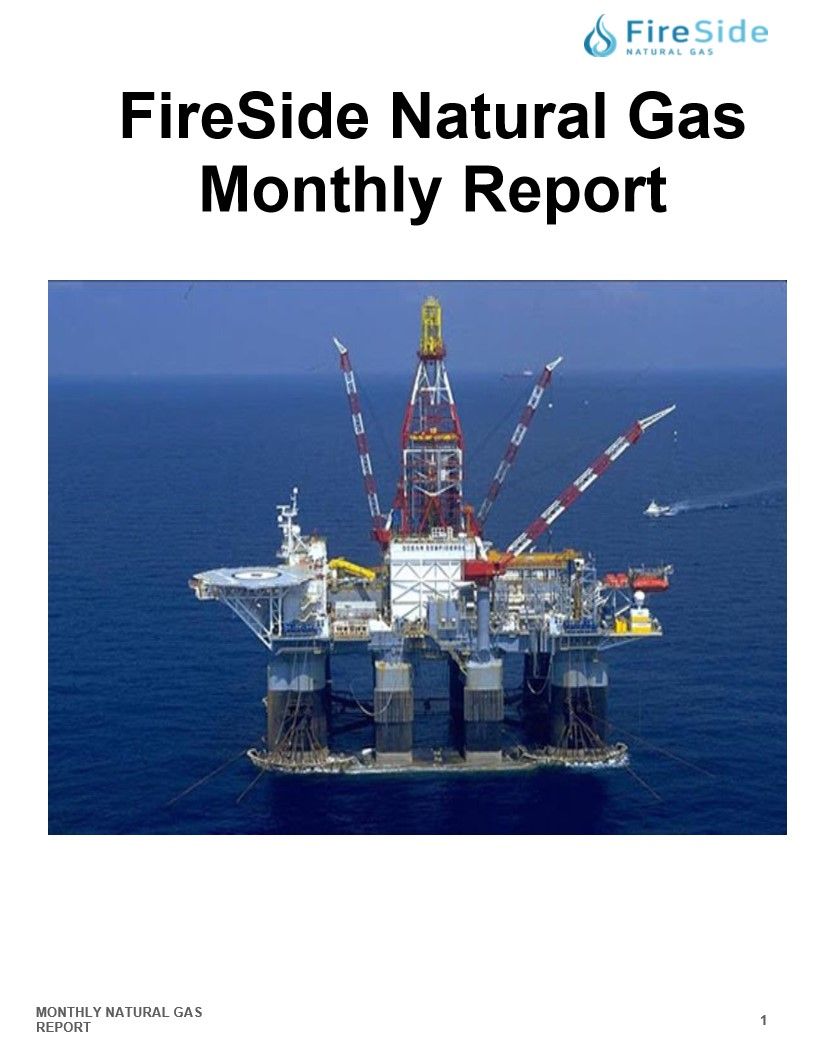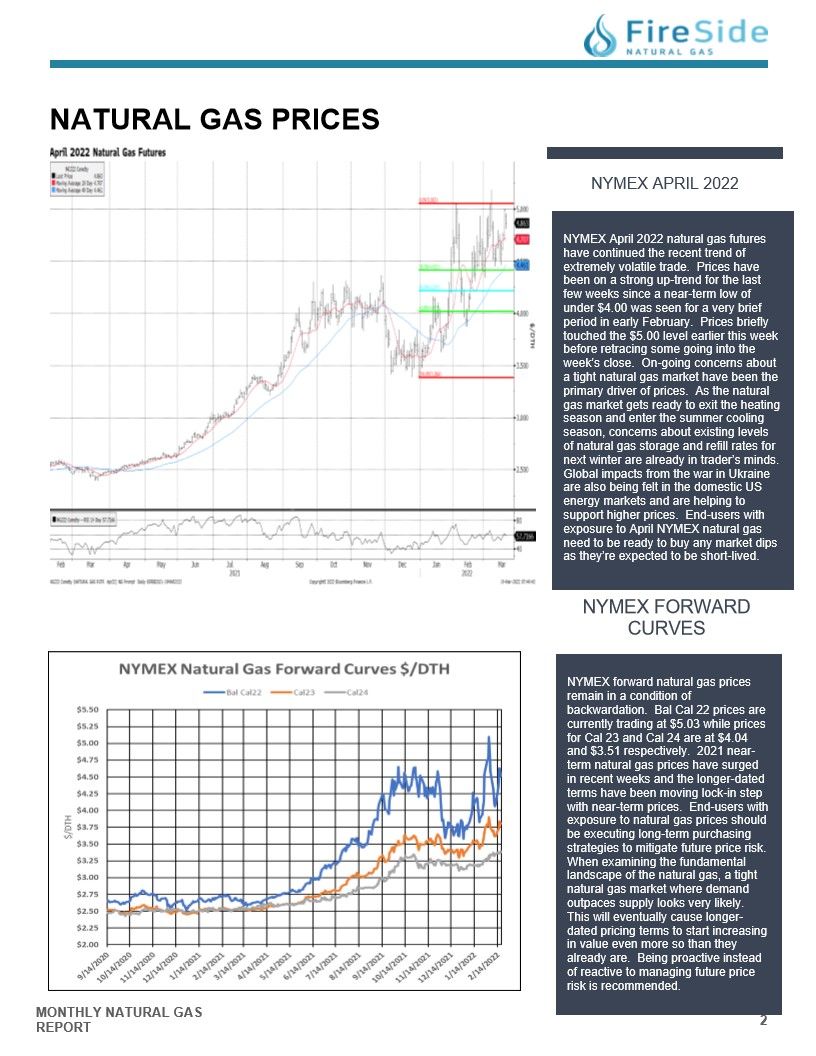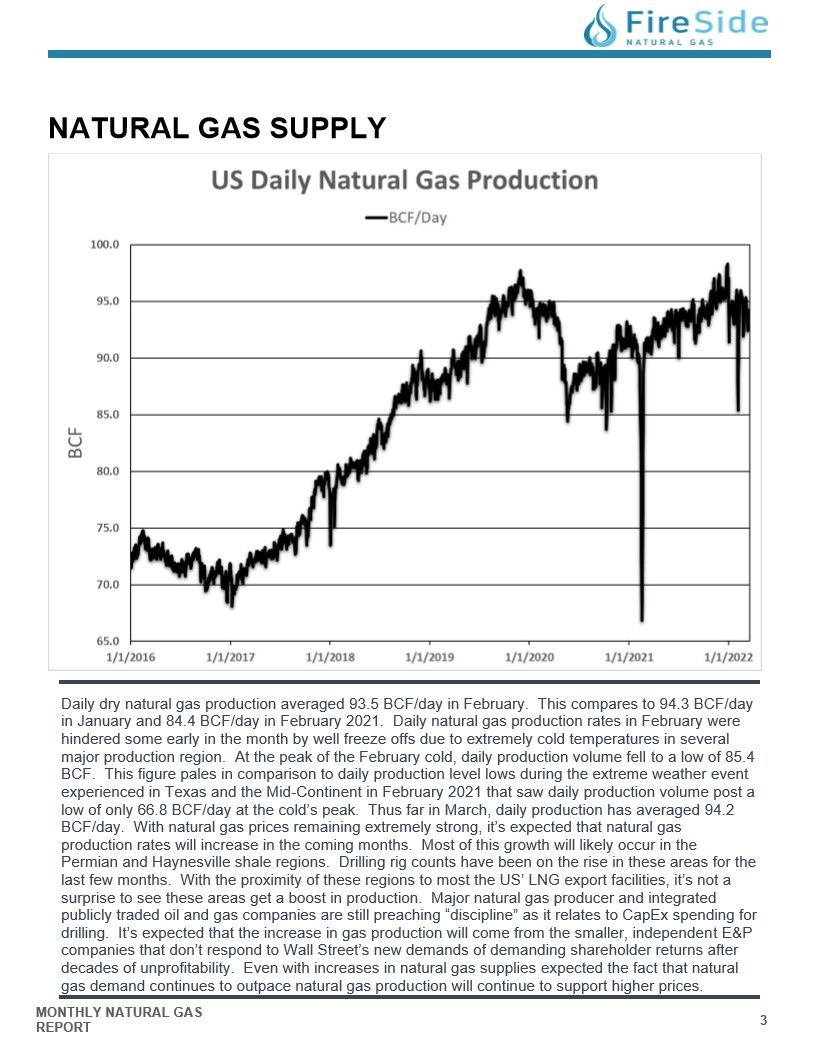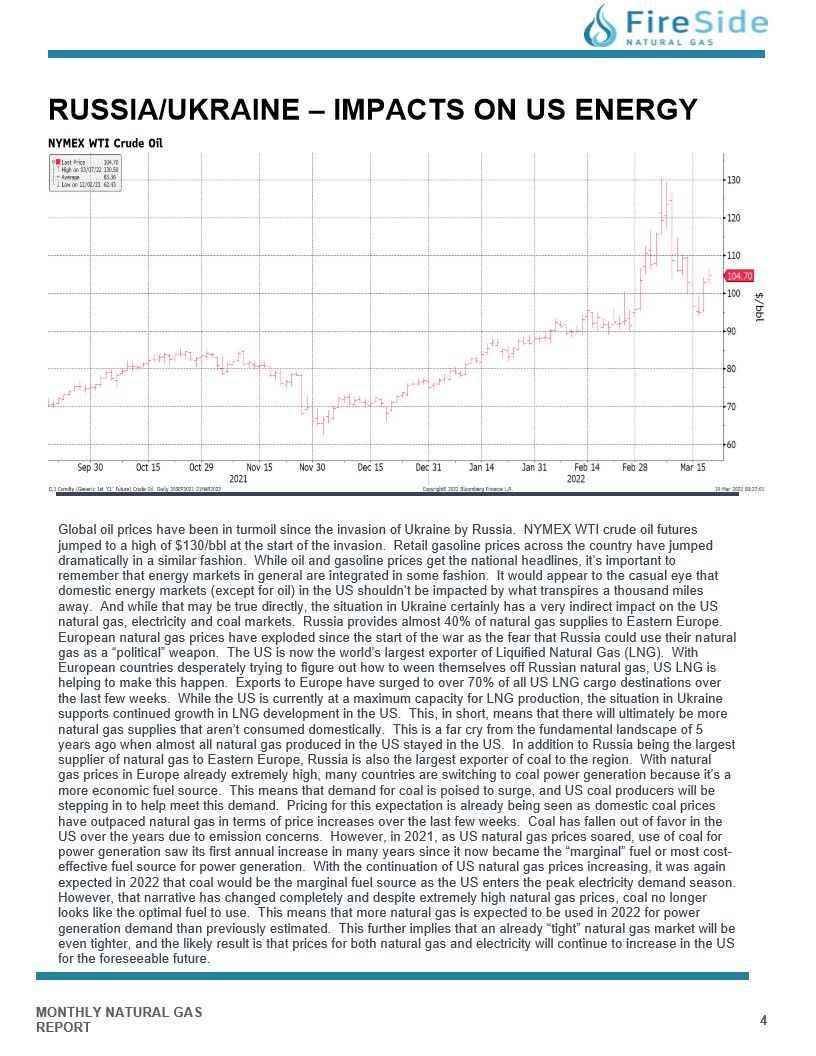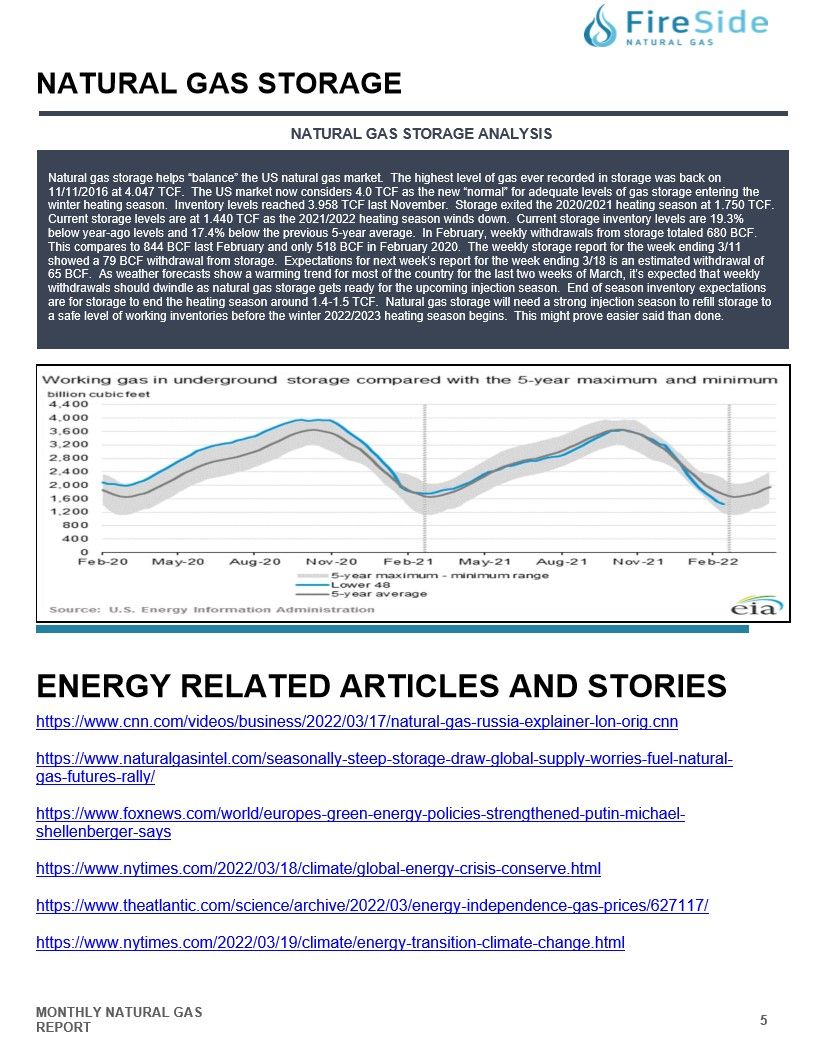The Monthly Natural Gas Market Newsletter - March 2022
NYMEX APRIL 2022
NYMEX April 2022 natural gas futures
have continued the recent trend of
extremely volatile trade. Prices have
been on a strong up-trend for the last
few weeks since a near-term low of
under $4.00 was seen for a very brief
period in early February. Prices briefly
touched the $5.00 level earlier this week
before retracing some going into the
week's close. On-going concerns about
a tight natural gas market have been the
primary driver of prices. As the natural
gas market gets ready to exit the heating
season and enter the summer cooling
season, concerns about existing levels
of natural gas storage and refill rates for
next winter are already in trader's minds.
Global impacts from the war in Ukraine
are also being felt in the domestic US
energy markets and are helping to
support higher prices. End-users with
exposure to April NYMEX natural gas
need to be ready to buy any market dips
as they're expected to be short-lived.
NYMEX FORWARD CURVES
NYMEX forward natural gas prices
remain in a condition of
backwardation. Bal Cal 22 prices are
currently trading at $5.03 while prices
for Cal 23 and Cal 24 are at $4.04
and $3.51 respectively. 2021 near-term natural gas prices have surged
in recent weeks and the longer-dated
terms have been moving lock-in step
with near-term prices. End-users with
exposure to natural gas prices should
be executing long-term purchasing
strategies to mitigate future price risk.
When examining the fundamental
landscape of the natural gas, a tight
natural gas market where demand
outpaces supply looks very likely.
This will eventually cause longer dated pricing terms to start increasing
in value even more so than they
already are. Being proactive instead
of reactive to managing future price
risk is recommended.
Natural Gas Supply - US Daily Natural Gas Production
Daily dry natural gas production averaged 93.5 BCF/day in February. This compares to 94.3 BCF/day
in January and 84.4 BCF/day in February 2021. Daily natural gas production rates in February were
hindered some early in the month by well freeze offs due to extremely cold temperatures in several
major production region. At the peak of the February cold, daily production volume fell to a low of 85.4
BCF. This figure pales in comparison to daily production level lows during the extreme weather event
experienced in Texas and the Mid-Continent in February 2021 that saw daily production volume post a
low of only 66.8 BCF/day at the cold's peak. Thus far in March, daily production has averaged 94.2
BCF/day. With natural gas prices remaining extremely strong, it's expected that natural gas
production rates will increase in the coming months. Most of this growth will likely occur in the
Permian and Haynesville shale regions. Drilling rig counts have been on the rise in these areas for the
last few months. With the proximity of these regions to most the US' LNG export facilities, it's not a
surprise to see these areas get a boost in production. Major natural gas producer and integrated
publicly traded oil and gas companies are still preaching "discipline" as it relates to CapEx spending for
drilling. It's expected that the increase in gas production will come from the smaller, independent E&P
companies that don't respond to Wall Street's new demands of demanding shareholder returns after
decades of unprofitability. Even with increases in natural gas supplies expected the fact that natural
gas demand continues to outpace natural gas production will continue to support higher prices.
RUSSIA/UKRAINE - IMPACTS ON US ENERGY
Global oil prices have been in turmoil since the invasion of Ukraine by Russia. NYMEX WTI crude oil futures
jumped to a high of $130/bbl at the start of the invasion. Retail gasoline prices across the country have jumped
dramatically in a similar fashion. While oil and gasoline prices get the national headlines, it's important to
remember that energy markets in general are integrated in some fashion. It would appear to the casual eye that
domestic energy markets (except for oil) in the US shouldn't be impacted by what transpires a thousand miles
away. And while that may be true directly, the situation in Ukraine certainly has a very indirect impact on the US
natural gas, electricity and coal markets. Russia provides almost 40% of natural gas supplies to Eastern Europe.
European natural gas prices have exploded since the start of the war as the fear that Russia could use their natural
gas as a "political" weapon. The US is now the world's largest exporter of Liquified Natural Gas (LNG). With
European countries desperately trying to figure out how to wean themselves off Russian natural gas, US LNG is
helping to make this happen. Exports to Europe have surged to over 70% of all US LNG cargo destinations over
the last few weeks. While the US is currently at a maximum capacity for LNG production, the situation in Ukraine
supports continued growth in LNG development in the US. This, in short, means that there will ultimately be more
natural gas supplies that aren't consumed domestically. This is a far cry from the fundamental landscape of 5
years ago when almost all natural gas produced in the US stayed in the US. In addition to Russia being the largest
supplier of natural gas to Eastern Europe, Russia is also the largest exporter of coal to the region. With natural
gas prices in Europe already extremely high, many countries are switching to coal power generation because it's a
more economic fuel source. This means that demand for coal is poised to surge, and US coal producers will be
stepping in to help meet this demand. Pricing for this expectation is already being seen as domestic coal prices
have outpaced natural gas in terms of price increases over the last few weeks. Coal has fallen out of favor in the
US over the years due to emission concerns. However, in 2021, as US natural gas prices soared, use of coal for
power generation saw its first annual increase in many years since it now became the "marginal" fuel or most cost-effective fuel source for power generation. With the continuation of US natural gas prices increasing, it was again
expected in 2022 that coal would be the marginal fuel source as the US enters the peak electricity demand season.
However, that narrative has changed completely and despite extremely high natural gas prices, coal no longer
looks like the optimal fuel to use. This means that more natural gas is expected to be used in 2022 for power
generation demand than previously estimated. This further implies that an already "tight" natural gas market will be
even tighter, and the likely result is that prices for both natural gas and electricity will continue to increase in the US
for the foreseeable future.
Natural Gas Storage Analysis
Natural gas storage helps "balance" the US natural gas market. The highest level of gas ever recorded in storage was back on
11/11/2016 at 4.047 TCF. The US market now considers 4.0 TCF as the new "normal" for adequate levels of gas storage entering the
winter heating season. Inventory levels reached 3.958 TCF last November. Storage exited the 2020/2021 heating season at 1.750 TCF.
Current storage levels are at 1.440 TCF as the 2021/2022 heating season winds down. Current storage inventory levels are 19.3%
below year-ago levels and 17.4% below the previous 5-year average. In February, weekly withdrawals from storage totaled 680 BCF.
This compares to 844 BCF last February and only 518 BCF in February 2020. The weekly storage report for the week ending 3/11
showed a 79 BCF withdrawal from storage. Expectations for next week's report for the week ending 3/18 is an estimated withdrawal of
65 BCF. As weather forecasts show a warming trend for most of the country for the last two weeks of March, it's expected that weekly
withdrawals should dwindle as natural gas storage gets ready for the upcoming injection season. End of season inventory expectations
are for storage to end the heating season around 1.4-1.5 TCF. Natural gas storage will need a strong injection season to refill storage to
a safe level of working inventories before the winter 2022/2023 heating season begins. This might prove easier said than done.
Energy Related Articles and Stories
https://www.cnn.com/videos/business/2022/03/17/natural-gas-russia-explainer-lon-orig.cnn
https://www.nytimes.com/2022/03/18/climate/global-energy-crisis-conserve.html
https://www.theatlantic.com/science/archive/2022/03/energy-independence-gas-prices/627117/
https://www.nytimes.com/2022/03/19/climate/energy-transition-climate-change.htm
